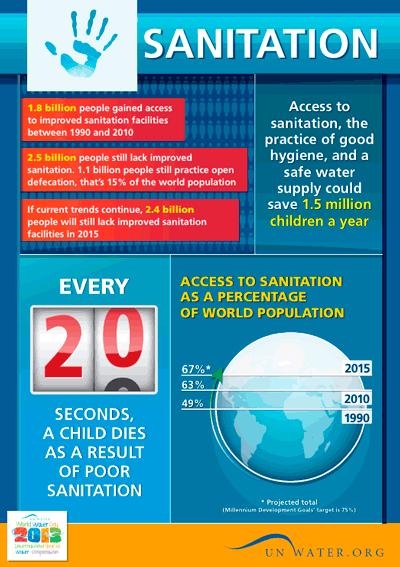- ON THE DECADE
- THE DECADE'S CAMPAIGN
- REPORTING ON PROGRESS
- THE DECADE'S PROGRAMMES
- FOCUS AREAS
-
- Access to sanitation
- Financing water
- Gender and water
- Human right to water
- Integrated Water Resources Management
- Transboundary waters
- Water and cities
- Water and energy
- Water and food security
- Water and sustainable development
- Water and the green economy
- Water cooperation
- Water quality
- Water scarcity
- FOCUS REGIONS
- RESOURCES FOR
- UN e-RESOURCES
Access to sanitation
The United Nations estimates that there are 2.5 billion people who still do not use an improved sanitation facility and a little over 1 billion practising open defecation.
In 2011, almost two thirds (64%) of the world, relied on improved sanitation facilities. Since 1990, almost 1.9 billion people have gained access to an improved sanitation facility. The greatest progress has been made in Eastern Asia, where sanitation coverage has increased from 27% in 1990 to 67% in 2011. This amounts to more than 626 million people gaining access to improved sanitation facilities over a 21-year period. However, current trends show sub-Saharan Africa and Southern Asia still struggle with low sanitation coverage. In sub-Saharan Africa, 44 per cent of the population uses either shared or unimproved facilities, and an estimated 26 per cent practices open defecation while in Southern Asia, the proportion of the population using shared or unimproved facilities has declined to 18 per cent but open defecation remains the highest of any region (39 per cent).
Open defecation rates declined globally from 24% in 1990 to 15% in 2011. In absolute numbers, this signifies a drop of 244 million people to 1.04 billion in 2011. The decline in the population practising open defecation has differed from region to region. Eastern Asia, South-eastern Asia and the Latin America and Caribbean regions have seen a steady decline since earliest measurements describing conditions in 1990. In Southern Asia, the population practising open defecation peaked around 1995, after which it declined. Only in sub-Saharan Africa is the number of people defecating in the open still increasing.
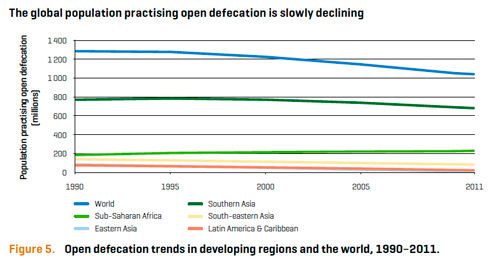
The state of sanitation remains a powerful indicator of the state of human development in any community. Access to sanitation bestows benefits at many levels. Cross-country studies show that the method of disposing of excreta is one of the strongest determinants of child survival: the transition from unimproved to improved sanitation reduces overall child mortality by about a third. Improved sanitation also brings advantages for public health, livelihoods and dignity-advantages that extend beyond households to entire communities.
Sources:
- Progress on Drinking Water and Sanitation. 2013 update. UNICEF, WHO, March 2013.
- Progress on Drinking Water and Sanitation. 2012 update. UNICEF, WHO, March 2012.
- Human Development Report 2006. United Nations Development Programme (UNDP), 2006.
Sanitation and the MDGs
The Millennium Development Goal 7 (MDG7) Target 10 is to halve by 2015 the proportion of people without sustainable access to safe drinking water and basic sanitation. The world remains off track to meet the MDG sanitation target of 75% and if current trends continue, is set to miss the target by more than half a billion people. Unless the pace of change in the sanitation sector can be accelerated, the MDG target may not be reached until 2026.
Unless the pace of change in the sanitation sector can be accelerated, the MDG target may not be reached until 2026.
What is “basic sanitation”?
Basic sanitation is improved sanitation. Facilities that ensure hygienic separation of human excreta from human contact. They include:
- Flush or pour-flush toilet/latrine to a piped sewer system, a septic tank or a pit latrine.
- Ventilated improved pit latrine.
- Pit latrine with slab.
- Composting toilet.
Source: Joint Monitoring Programme (JMP).
Did you know?
- 2.5 billion people – roughly 37 per cent of the world’s population – still lack what many of us take for granted: access to adequate sanitation.
- Open defecation is one of the main causes of diarrhoea, which results in the deaths of more than 750,000 children under age 5 every year.
- Every 20 seconds a child dies as a result of poor sanitation.
- 80 per cent of diseases in developing countries are caused by unsafe water and poor sanitation, including inadequate sanitation facilities.
- Access to sanitation, the practice of good hygiene, and a safe water supply could save 1.5 million children a year.
- In 2006, the world’s population was almost equally divided between urban and rural dwellers. Nevertheless, more than 7 out of 10 people without improved sanitation were rural inhabitants.
- Doing nothing is costly. Every US $1 spent on sanitation brings a $5.50 return by keeping people healthy and productive.
Source:
- Fact sheet on water and sanitation. Rio+20 United Nations Conference on Sustainable Development

- UN-Water Sanitation Fact sheet

- Sanitation Drive 2015 Fact sheets
UN initiatives which are helping to raise the issue...
- End Open Defecation Campaign
This campaign, launched by UN Deputy Secretary General Jan Eliasson on 28 May 2014, aims to help end the practice of open defecation and improve access to toilets and latrines for the 2.5 billion people without basic level sanitation. The campaign, which will run to the end of 2015, aims to break the silence - the silence on talking about open defecation and the silence on the deaths and diseases, particularly among children, that have occurred a result of open defecation practices and lack of decent toilets or latrines.
- World Toilet Day
This international day of action aims to break the taboo around toilets and draw attention to the global sanitation challenge. Celebrated on 19 November since 2001, the day has been recognized in 2013 by the United Nations General Assembly.
>> UN General Assembly Resolution proclaiming World Toilet Day
- Sustainable sanitation: The Five-Year-Drive to 2015
The Sanitation Drive to 2015 is an advocacy campaign working to meet the Millennium Development Goal sanitation target and end open defecation. The campaign supports and inspires people from around the world to take action towards achieving sanitation and hygiene for all by targeting the poorest and most vulnerable people. - UN Deputy Secretary-General's Call to Action on Sanitation
Recognizing that greater progress on sanitation is essential for fighting poverty and for achieving all the Millennium Development Goals, UN Deputy Secretary-General Jan Eliasson has initiated, on behalf of UN Secretary-General, a renewed effort to drive progress on sanitation and water goals towards the 2015 target date and beyond. - 2008: International Year of Sanitation
2008 was declared International Year of Sanitation. It helped to put sanitation in the spotlight and led to the launch of several initiatives to more vigorously address the current sanitation crisis. - UN-Water Thematic Priority Area on Water Supply and Basic Sanitation
The Thematic Priority Area on Water Supply and Basic Sanitation was created to support the efforts made in achieving the goal of providing safe water and sanitation for all. It intends to foster collaboration between UN agencies, provide value added services to the UN and its Member States, support initiatives that facilitate achievement of the relevant development goals, raise awareness and support UN global advocacy on water supply and basic sanitation, and coordinate with non-UN-Water initiatives related to water supply and basic sanitation.
To know more
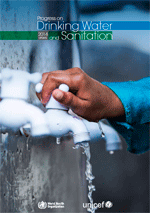 Progress on Drinking Water and Sanitation. 2014 update
Progress on Drinking Water and Sanitation. 2014 update
WHO/UNICEF Joint Monitoring Programme for Water Supply and Sanitation (JMP). May 2014
This Progress on Drinking Water and Sanitation report evaluates access to drinking-water and sanitation worldwide and progress towards related targets under Millennium Development Goal 7 "to halve, by 2015, the proportion of the population without sustainable access to safe drinking water and basic sanitation". Section 1 presents the status of and trends in access to improved drinking water sources and sanitation. Section 2 provides a snapshot of inequalities in access to improved drinking water sources and sanitation. Section 3 presents efforts to strengthen monitoring of access to safe drinking water and sanitation services under a post-2015 development agenda, as well as the challenges associated with these efforts.
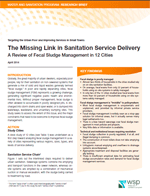 The Missing Link in Sanitation Service Delivery. A Review of Fecal Sludge Management in 12 Cities
The Missing Link in Sanitation Service Delivery. A Review of Fecal Sludge Management in 12 Cities
World Bank Water and Sanitation Program (WSP). April 2014
Globally, the great majority of urban dwellers, especially poor people, rely for their sanitation on non-sewered systems that generate a mix of solid and liquid wastes generally termed fecal sludge. In poor and rapidly expanding cities, fecal sludge management represents a growing challenge, generating significant negative public health and environmental risks. Without proper management, fecal sludge is often allowed to accumulate in poorly designed pits, is discharged into storm drains and open water, or is dumped into waterways, wasteland, and unsanitary dumping sites. This research brief seeks to assess the extent of this issue, and the major constraints that need to be overcome to improve fecal sludge management. By compiling data from cities in the regions of Latin America, Africa, South Asia and East Asia and presenting them side by side the brief documents some relative key findings.
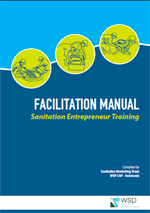 Facilitation Manual – Sanitation Entrepreneur Training
Facilitation Manual – Sanitation Entrepreneur Training
Water and Sanitation Programme (WSP). 2014
This compilation of documents is the official manual for the implementation of Sanitation Entrepreneur Training. This manual aims to provide a comprehensive reference for planning, implementation, monitoring and evaluations. It consists of four sections and appendices: background and training objectives; the pre-training phase; the training phase; post training (monitoring phase) and is meant to be used as a whole. This manual was developed by a team of facilitators and resource people who have experience in implementing training in provinces across Indonesia between 2008 and 2013. When used for implementing training, the manual should be adapted as necessary to ensure that the objectives and expected outcomes of the training are relevant to local conditions where the training is being done.
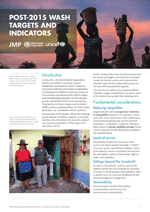 WASH Post-2015 proposed targets and indicators for drinking-water, sanitation and hygiene
WASH Post-2015 proposed targets and indicators for drinking-water, sanitation and hygiene
World Bank Water and Sanitation Program (WSP). March 2014
This document summarizes the latest proposals for post-2015 targets developed by global Water, Sanitation and Hygiene (WASH) stakeholders. In May 2011, anticipating the debate that would inevitably arise about what should succeed the Millennium Development Goals (MDGs), the World Health Organization (WHO) and UNICEF convened a global stakeholder meeting to consider which targets and indicators would be appropriate for drinking-water, sanitation and hygiene (WASH) post-2015.
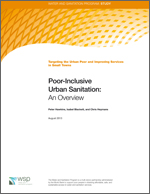 Poor-Inclusive Urban Sanitation: An Overview
World Bank Water and Sanitation Program (WSP). August 2013
Poor-Inclusive Urban Sanitation: An Overview
World Bank Water and Sanitation Program (WSP). August 2013
Delivering poor-inclusive urban sanitation requires improved service delivery, rather than a focus on infrastructure. This is the core finding of this global review on challenges, trends, and approaches at the global, national and city levels to achieve viable poor-inclusive urban sanitation at scale. The paper highlights key observations and lessons from the original study report: “Delivering Sanitation to the Urban Poor: A Scoping Study” (2012, unpublished).
 Technical Support Team Issues Brief: Water and Sanitation
UN-Water. May 2013
Technical Support Team Issues Brief: Water and Sanitation
UN-Water. May 2013
This issues brief summarizes main water and sanitation-related commitments made by Member States at Rio+20, different proposals for integrating water and sanitation issues into the Sustainable Development Goals (SDG) framework, and some reflections from the Post‐2015 Global Thematic Consultation on Water.
 Progress on sanitation and drinking-water: 2013 update
WHO/UNICEF Joint Monitoring Programme for Water Supply and Sanitation (JMP). May 2013
Progress on sanitation and drinking-water: 2013 update
WHO/UNICEF Joint Monitoring Programme for Water Supply and Sanitation (JMP). May 2013
This Progress on Drinking Water and Sanitation reports on access to drinking-water and sanitation worldwide and on progress towards related targets under Millennium Development Goal 7 "to halve, by 2015, the proportion of the population without sustainable access to safe drinking water and basic sanitation". The estimates presented in the 2013 report describe the situation as of end-2011. This 2013 update presents country and regional estimates for the year 2011 and global trends in sanitation, open defecation and access to drinking-water for the period 1990-2011. It also introduces the process of formulating proposals for post-2015 targets and corresponding indicators for water, sanitation and hygiene (WASH).
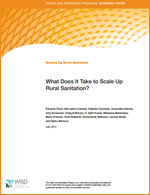 What Does It Take to Scale Up Rural Sanitation?
What Does It Take to Scale Up Rural Sanitation?
World Bank Water and Sanitation Program (WSP). July 2012
This Working Paper synthesizes the work of the WSP in operationalizing sustainable rural
sanitation and shares lessons learned. Key components are introduced and illustrated with
examples from the field: Chapter I. 'Overview' shares the sector context that shaped WSP's
approach to rural sanitation; the status of rural sanitation in countries where the program
was initially implemented; and introduces the programmatic and operational approaches
that have been tested at scale; Chapter II. 'Programmatic Approaches to Create Demand,
Change Behaviours, and Increase Supply' offers an overview to programmatic approaches
that have been combined and tested to create demand, change behaviours, and improve
supply chains: Community-Led Total Sanitation, Behaviour Change Communication, and
Sanitation Marketing. Sections introduce the basic methodology for these approaches,
illustrated by examples from fieldwork; Chapter III. 'Operationalizing the Programmatic
Approach for Service Delivery at Scale' looks at the roles of national and local government
and the local private sector, and discusses strategies to strengthen the enabling environment and build capacity to achieve and sustain improvements in rural sanitation; Chapter IV. 'From Learning to Knowledge to Action' highlights some of the strategies that were used to
generate, disseminate, and apply evidence-based learning, and key lessons to date;
Chapter V. 'Conclusion' reflects back and looks ahead to next-generation learning questions.
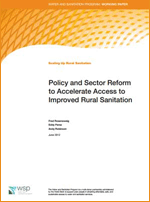 Policy and Sector Reform to Accelerate Access to Improved Rural Sanitation
World Bank Water and Sanitation Program (WSP). June 2012
Policy and Sector Reform to Accelerate Access to Improved Rural Sanitation
World Bank Water and Sanitation Program (WSP). June 2012
This document synthesizes key findings, conclusions, and recommendations from country
specific endline assessment reports from India, Indonesia, and Tanzania to provide
guidance and insight to other countries seeking to create large-scale sustainable rural
sanitation programs.
 Global costs and benefits of drinking-water supply and sanitation interventions to reach the MDG target and universal coverage
Global costs and benefits of drinking-water supply and sanitation interventions to reach the MDG target and universal coverage
World Health Organization (WHO). May 2012
This study aims to estimate global, regional and country-level costs and benefits of drinking-water supply and sanitation interventions to meet the MDG target in 2015, and to attain universal coverage. The report updates previous economic analyses conducted by the
World Health Organization, using new Water Supply and Sanitation (WSS) coverage rates,
costs of services, income levels and health indicators. Benefit-cost ratios (BCR) and costs
are estimated to meet the MDG drinking water and sanitation target and to attain universal
access of basic services. Rural and urban areas are analysed as separate.
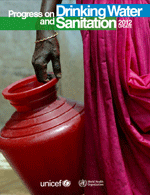 Progress on Drinking Water and Sanitation: 2012 update
Progress on Drinking Water and Sanitation: 2012 update
WHO/UNICEF Joint Monitoring Programme for Water Supply and Sanitation (JMP). March 2012
This Progress on Drinking Water and Sanitation reports every two years on access to drinking water and sanitation worldwide and on progress towards related targets under Millennium Development Goal 7 ‘to halve, by 2015, the proportion of the population without sustainable access to safe drinking water and basic sanitation’. The estimates presented in the 2012 report describe the situation as of end-2010 and supersede those of the JMP update published in March 2010. Monitoring draws on the findings of household surveys and censuses usually supported by national statistics bureaus.
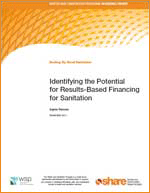 Identifying the Potential for Results-Based Financing for Sanitation
Identifying the Potential for Results-Based Financing for Sanitation
World Bank Water and Sanitation Program (WSP). November 2011
This working paper aims to identify practical ideas for advancing the use of innovative financing mechanisms focused on results and performance, with a view to supporting the delivery of sustainable sanitation services. To this end, the document reviews: (1) The rationale for examining Results-Based Financing (RBF) instruments for sanitation; (2) Current issues with sanitation, where "misaligned incentives" mean that inadequate services are being provided or demanded; (3) How public funding, if allocated based on results, could help with realigning incentives; and (4) Common issues and challenges with the design of RBF instruments.
 Introductory Guide to Sanitation Marketing
Introductory Guide to Sanitation Marketing
World Bank Water and Sanitation Program (WSP). September 2011
This document seeks to contribute to the field of sanitation marketing by sharing practical guidance on the design, implementation, and monitoring of rural sanitation marketing programs at scale in India, Indonesia, and Tanzania, plus additional projects implemented in Cambodia and Peru. The goal of the guide is to (1) Define sanitation marketing and the key components of a sanitation marketing initiative; (2) Provide an overall framework for scaling up rural sanitation programs and the justification for using a sanitation marketing approach; (3) Explain the steps needed to design, implement, and monitor sanitation marketing programs at scale; (4) Provide practical guidance on implementation; (5) Share concrete examples and lessons learned based on WSP's experiences to date; and (6) Highlight key challenges and recommend solutions.
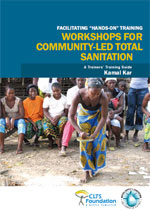 Facilitating ‘Hands On Training’ Workshops for Community-Led Total Sanitation: A Trainers’ Training Guide
[ 1.62 MB]
Facilitating ‘Hands On Training’ Workshops for Community-Led Total Sanitation: A Trainers’ Training Guide
[ 1.62 MB]
Water Supply and Sanitation Collaborative Council (WSSCC), CLTS Foundation. 2010
Community-Led Total Sanitation (CLTS) is spreading fast in many countries in different regions, and there is growing demand for facilitators and trainers of facilitators. This guide, produced by WSSCC and the CLTS Foundation, and authored by Kamal Kar, fulfils the need for a resource that will support the creation of a strong cadre of trainers for front-line CLTS work.
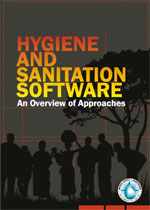 Hygiene and Sanitation Software: An Overview of Approaches
[ 3.44 MB]
Hygiene and Sanitation Software: An Overview of Approaches
[ 3.44 MB]
Water Supply and Sanitation Collaborative Council (WSSCC). 2010
Since the 1970s, sanitation and hygiene professionals have strived to find ways to engage target groups (individuals, households, communities, institutions or even organisations) in development programmes that facilitate sanitation and hygiene behaviour change, or create a demand for related services. These are ‘software’ methods or approaches, as opposed to ‘hardware’ such as toilets and pipes. This new resource presents in one place the latest thinking and most common software approaches for improving the political, legal, institutional, financial and economic, educational, technical and social conditions within which hygiene and sanitation programmes operate.
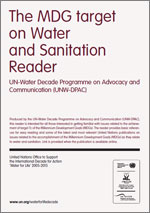 The MDG target on Water and Sanitation - Reader
The MDG target on Water and Sanitation - Reader
[149 KB]
UN-Water Decade Programme on Advocacy and Communication (UNW-DPAC). 2010
This reader is intended for all those interested in getting familiar with issues related to the achievement of target 7c of the Millennium Development Goals (MDGs). The reader provides basic references for easy reading and some of the latest and most relevant United Nations publications on issues related to the accomplishment of the Millennium Development Goals (MDGs) as they relate to water and sanitation. Link is provided when the publication is available online.
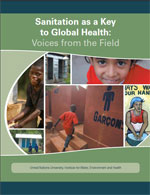 Sanitation as a Key to Global Health: Voices from the Field
Sanitation as a Key to Global Health: Voices from the Field
[ 2.4 MB]
United Nations University Institute for Water, Environment and Health (UNU-INWEH). 2010
In October 2008 the United Nations University Institute for Water, Environment and Health invited international representatives from NGOs, government, academia and the UN to a meeting to discuss barriers and to identify breakthroughs to providing sanitation for all. This document has been compiled to summarize these discussions, place them within the current global context, illustrate them with stories from the field and provide recommendations for addressing the global sanitation crisis.
10 Things you need to know about sanitation
[84 KB]
United Nations Children’s Fund (UNICEF), World Health Organization (WHO), Water Supply and Sanitation Collaborative Council (WSSCC). 2008
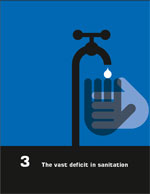 Human Development Report 2006. Chapter 3 ‘The vast deficit in sanitation’
[434.6 KB]
Human Development Report 2006. Chapter 3 ‘The vast deficit in sanitation’
[434.6 KB]
United Nations Development Programme (UNDP). 2006
This chapter of the Human Development Report, highlights the scale of the global deficit in sanitation. After briefly outlining the contours of the sanitation deficit, it asks why progress in reducing that deficit has been so slow, and it identifies some of the structural factors that explain why advances in sanitation have lagged behind those in water. The chapter explores some of the policies and strategies that have created an environment for accelerated progress.
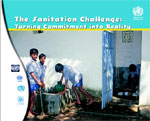 The Sanitation Challenge: Turning Commitment into Reality
The Sanitation Challenge: Turning Commitment into Reality
[549 KB]
World Health Organization (WHO). 2004
The provision of sanitation is a key development intervention. Despite its importance, achieving real gains in sanitation coverage has been slow. Scaling up and increasing the effectiveness of investments in sanitation need to be accelerated to meet the ambitious targets agreed at Johannesburg. This document summarises the key thinking about how these targets can be met. It suggests actions that can be taken at different levels and by different actors to change the pace of sanitation improvement.
Access to sanitation around the world
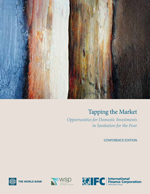 Tapping the Market: Opportunities for Domestic Investments in Sanitation for the Poor
Tapping the Market: Opportunities for Domestic Investments in Sanitation for the Poor
World Bank Water and Sanitation Program (WSP), International Finance Corporation (IFC). August 2013
This report examines private sector provision of on-site sanitation services in Bangladesh, Indonesia, Peru, and Tanzania, four countries where the local private sector already plays a major role in the construction and maintenance of sanitation in rural (and many urban) areas. In each country, the study examines the preferences and circumstances of poor households and the performance of enterprises that provide sanitation-related services directly to them. It examines commercial and investment climate factors that may affect enterprises’ actual or perceived costs and risks, driving their decisions about increasing investment in their business.
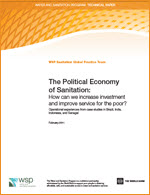 (The) political economy of sanitation: How can we increase investment and improve service for the poor? Operational experiences from case studies in Brazil, India, Indonesia, and Senegal
(The) political economy of sanitation: How can we increase investment and improve service for the poor? Operational experiences from case studies in Brazil, India, Indonesia, and Senegal
World Bank Water and Sanitation Program (WSP). February 2011
This report presents the results of a Global Economic and Sector Work Study on the Political Economy of Sanitation in Brazil, India, Indonesia, and Senegal that was conducted by the Water and Sanitation Program (WSP) and the World Bank. The purpose of the study was to help WSP and the World Bank—through a better understanding of the political economy of sanitation—in their efforts to support partner countries and development practitioners in the de¬sign, implementation, and effectiveness of operations that aim to provide pro-poor sanitation investments and services to improve health and hygiene outcomes. This Synthesis Report is based on the findings from the secondary literature review and the results of primary research in the four case study countries, which examined how each had identified and managed political economy risks and opportunities in its sanitation interventions.
Africa
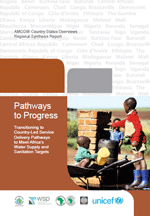 Pathways to Progress. Transitioning to Country-Led Service Delivery Pathways to Meet Africa's Water Supply and Sanitation Targets
Pathways to Progress. Transitioning to Country-Led Service Delivery Pathways to Meet Africa's Water Supply and Sanitation Targets
World Bank Water and Sanitation Program (WSP), African Ministers' Council on Water (AMCOW). August 2011
This document is the regional synthesis of the 32 country status overviews which collectively account for 95 percent of Sub-Saharan Africa's population and over 90 percent of GDP. The report highlights the most important trends, challenges, and proposed actions for achieving improved water supply and sanitation services across Sub-Saharan Africa. The opportunities for progress are identified based on:
- Understanding trends: The report analyzes regional performance, the relative progress of individual countries, and progress of groups of countries classified by a combination of political and economic factors. The report considers separately the four water and sanitation subsectors in each country: rural water supply; urban water supply; rural sanitation; and, urban sanitation;
- Identifying the challenge: For each country and subsector, Country Status Overviews explore the links between inputs (finance) and outcomes (coverage) through the lens of a 'service delivery pathway', which is systematically assessed to identify the major barriers that still constrain performance in each subsector;
- Prioritizing action: The report builds on the insights from the Country Status Overviews scorecard to provide senior managers in the sector and their development partners with proposals on prioritizing reform and investment options that match the relevant stages of subsector evolution in each country.
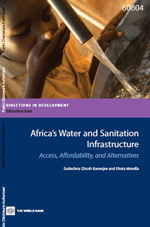 Africa's Water and Sanitation Infrastructure. Access, Affordability and Alternatives
Africa's Water and Sanitation Infrastructure. Access, Affordability and Alternatives
International Bank for Reconstruction and Development (IBRD), World Bank. January 2011
This publication integrates a wealth of primary and secondary information to present a quantitative snapshot of the state of the water supply and sanitation (WSS) sectors in Africa. It explains the sectoral institutional structures and utility performance and articulates the volume and quality of financing available over time. The authors also evaluate the challenges to the WSS sectors and explore the factors that govern the expansion of coverage over time. Finally, the authors estimate spending needs for WSS, arriving at a funding gap for meeting the MDGs. The proposed directions for the future draw on lessons learned from best practices and present the menu of choices available to African countries, bearing in mind that the challenges differ to a significant extent among countries and solutions must be tailored to national or regional conditions.
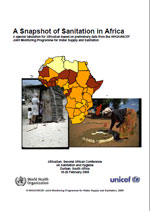 A Snapshot of Sanitation in Africa [1.82 MB]
A Snapshot of Sanitation in Africa [1.82 MB]
World Health Organization (WHO), United Nations Children's Fund (UNICEF) – Joint Monitoring Programme (JMP). 2008
This tabulation has been prepared by the WHO/UNICEF Joint Monitoring Programme for Water Supply and Sanitation (JMP) as its contribution to the Second African Conference on Sanitation and Hygiene, held in Durban, South Africa in February 2008. It contains a new set of sanitation coverage estimates for Africa for the year 2006 based on preliminary JMP estimates. The estimates presented in this document originate from data collected by national statistics offices along with other relevant institutions through national censuses and nationally representative household surveys, including Demographic and Health Surveys (DHS), Multiple Indicator Cluster Surveys (MICS) and World Health Surveys among others.
Asia and the Pacific
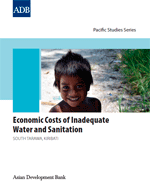 Economic Costs of Inadequate Water and Sanitation: South Tarawa, Kiribati
Economic Costs of Inadequate Water and Sanitation: South Tarawa, Kiribati
Asian Development Bank (ADB). April, 2014
This study seeks to estimate and quantify the total economic costs of the inadequate water supply and sanitation situation in Kiribati’s main urban centre, South Tarawa. It also aims to demonstrate that vulnerable groups such as women are most likely to bear a disproportionate amount of the economic costs associated with low levels of access and poor quality of basic water supply and sanitation services. It is intended to be used to inform the design of reforms in improving the urban water supply and sanitation sector performance as a means of supporting more sustainable urban development in Kiribati and serve as a useful reference to policy makers and advisers in other Pacific developing member countries in planning for urban water and sanitation investment and policy changes. The four chapters cover: Analysis of the water supply and sanitation situation; Impacts of poor water and sanitation; Economic costs of inadequate water and sanitation and; Reducing economic burden of poor water and sanitation; followed by a conclusive summary of findings.
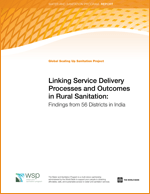 Linking Service Delivery Processes and Outcomes in Rural Sanitation: Findings from 56 districts in India
Linking Service Delivery Processes and Outcomes in Rural Sanitation: Findings from 56 districts in India
World Bank Water and Sanitation Program (WSP). April 2013
The year 2012 marked the close of the Government of India's Total Sanitation Campaign (TSC). The program was started in 1999 to achieve universal rural sanitation coverage. Although rural sanitation coverage has increased during TSC, progress still falls short of the program goal of universal coverage. The objectives of this assessment are to: provide the Government of India with an overview of the range of service delivery processes adopted by different districts across states and their relative performance in terms of outcomes; identify which service delivery processes are linked to better (or worse) performance; and identify where the key bottlenecks are to achieving or sustaining outcomes.
 Economic Assessment of Sanitation Interventions in Yunnan Province, People's Republic of China. A six-country study conducted in Cambodia, China, Indonesia, Lao PDR, the Philippines and Vietnam under the Economics of Sanitation Initiative (ESI)
Economic Assessment of Sanitation Interventions in Yunnan Province, People's Republic of China. A six-country study conducted in Cambodia, China, Indonesia, Lao PDR, the Philippines and Vietnam under the Economics of Sanitation Initiative (ESI)
World Bank Water and Sanitation Program (WSP). September 2012
This study evaluates the costs and benefits of technical sanitation options and sanitation programs in Yunnan Province, China. The study compares the costs and benefits of alternative improved sanitation options over the expected life of each technology, to estimate efficiency of alternative sanitation options. For the study, sanitation options in eight different sites throughout Yunnan Province were selected, representing urban, peri-urban and rural areas as well as different socio-economic levels and cultural settings. Sanitation options evaluated in the study include the facilities to collect and convey human excreta, household wastewater treatment and related hygiene practices. The benefits of sanitation evaluated include health, water quality, time to access sanitation facilities, external environment, reuse of human excreta, quality of life improvement and other intangible benefits such as privacy, cleanliness and comfort. The costs of sanitation measured include investment costs and recurrent costs (operations and maintenance).
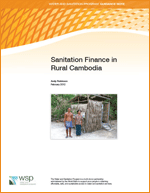 Sanitation Finance in Rural Cambodia
Sanitation Finance in Rural Cambodia
World Bank Water and Sanitation Program (WSP). February 2012
This document presents the findings of a study on sanitation finance in Cambodia. This guidance note contains an introduction on sanitation financing and subsidies, stating the cases for subsidies as well as some of their practical pitfalls. The study used data (as of late 2009) from two case studies of rural sanitation finance in Cambodia to illustrate the practical issues, supplemented by preliminary data from two sanitation marketing projects. The study also examined the potential use and effectiveness of (hardware) subsidies, conditional cash transfers (CCTs), and other financing approaches relevant for sanitation improvement. The document ends with recommendations for improved sanitation finance, including practical suggestions for sanitation programs in Cambodia.
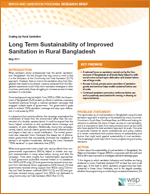 Long Term Sustainability of Improved Sanitation in Rural Bangladesh
Long Term Sustainability of Improved Sanitation in Rural Bangladesh
World Bank Water and Sanitation Program (WSP). April 2011
This research brief summarizes some of the key findings and main lessons extracted from the Bangladesh experience with the Community-Led Total Sanitation (CLTS) approach. The document also provides some insights for future programming which includes considerations for governments and sector professionals to sustain sanitation programming and behaviour change at scale.
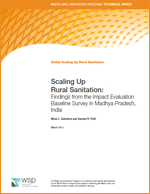 Scaling Up Rural Sanitation: Findings from the Impact Evaluation Baseline Survey in Madhya Pradesh, India
Scaling Up Rural Sanitation: Findings from the Impact Evaluation Baseline Survey in Madhya Pradesh, India
World Bank Water and Sanitation Program (WSP). March 2011
The goal of the WSP Global Scaling Up Rural Sanitation project is to reduce the risk of diarrhea and therefore increase household productivity by stimulating demand for sanitation in the lives of people in India, Indonesia, and Tanzania. This report summarizes the findings of the baseline and community surveys conducted in Madhya Pradesh, India, and is part of a series of papers analyzing the baseline data from all countries where the program has been implemented.
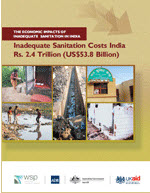 (The) Economic Impacts of Inadequate Sanitation in India
(The) Economic Impacts of Inadequate Sanitation in India
World Bank Water and Sanitation Program (WSP). December 2010
This study from India analyzes the evidence on the adverse economic impacts of inadequate sanitation at the national level using information on health (deaths and diseases) and other impacts. The study underlines that not only are substantial investments needed but that these can become effective only when they result in reducing morbidity and mortality, mitigating impacts on drinking water, improving welfare, and reducing impacts on tourism, and so on, which are associated with inadequate sanitation. The study recommends a new monitoring framework at the national and local levels—one that measures not just toilet coverage and use, or coverage of sewerage and number of wastewater treatment plants, but also the improvements in the overall health, water-related, environmental, and welfare indicators that are caused by inadequate sanitation.
 Managing the Flow of Monitoring Information to Improve Rural Sanitation in East Java
Managing the Flow of Monitoring Information to Improve Rural Sanitation in East Java
World Bank Water and Sanitation Program (WSP). December 2010
Global Scaling Up Rural Sanitation is a WSP project being implemented in India, Indonesia, and Tanzania. Working with local governments and the private sector in 29 districts of East Java province in Indonesia, WSP’s approach combines generating demand from local governments prior to initiating project interventions and demand from consumers for improved sanitation facilities and behaviours prior to making a greater range of sanitation products and services available through local markets. This demand responsive approach combines Community-Led Total Sanitation (CLTS), behaviour change communication, and sanitation marketing approaches to help villages become open defecation free (ODF). WSP’s experience with participatory monitoring in East Java has shown that communities are fully able and highly motivated to monitor progress toward ODF and that they can regularly track changes in community access to improved sanitation. However, during 2009 the project team observed that while monitoring data was being generated regularly in the communities, much of this data was not reaching sub-district, district, or higher levels for regular consolidation. With a focus on implementing sustainable approaches, WSP focused on integrating innovations with existing monitoring mechanisms used by local governments. This working paper documents how this system works and shares insights based on implementation to date.
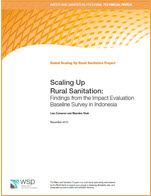 Scaling Up Rural Sanitation: Findings from the Impact Evaluation Baseline Survey in Indonesia
Scaling Up Rural Sanitation: Findings from the Impact Evaluation Baseline Survey in Indonesia
World Bank Water and Sanitation Program (WSP). November 2010
WSP’s Global Scaling Up Rural Sanitation Project, known as Sanitasi Total dan Pemasaran Sanitasi (SToPs) in Indonesia, aims to improve the sanitation practices in Indonesian rural communities, reaching a total of 1.4 million people in 29 rural districts in East Java by project end. This report summarizes the findings of the baseline survey conducted in Indonesia and is part of a series of papers presenting and analyzing descriptive findings from the baseline impact evaluation surveys conducted in 2008 and 2009 from all countries where the project has been implemented.
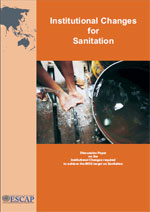 Institutional Changes required to achieve the MDG target on Sanitation: Survey and Experiences from the Asia-Pacific Region
[582.46 MB]
Institutional Changes required to achieve the MDG target on Sanitation: Survey and Experiences from the Asia-Pacific Region
[582.46 MB]
United Nations Economic Commission for Asia and the Pacific (UNESCAP). 2009
This report presents the institutional progress made in selected member countries towards achieving sanitation goals. Institutional progress consists of changes in administrative, legal and financial rules and practices that have been made with sanitation goals in mind. It also includes the “slow-moving” institutions, which are social norms and practices, general awareness of the public and the ensuing demand for sanitation services. In terms of administrative changes, the survey revealed that nine out of thirteen countries have created a sanitation coordination mechanism at the national level. Many governments have also undertaken legal reform, integrating sanitation into existing development plans or introducing decentralization laws that pass authority for sanitation to local governments. Few countries, however, have taken the needed step of providing adequate financial resources to local authorities, so that they can start investing in their jurisdictions.
 Economic Impacts of Sanitation in Southeast Asia
Economic Impacts of Sanitation in Southeast Asia
[2.64 MB]
World Bank. 2008
This study examines the major health, water, environmental, tourism and other welfare impacts associated with poor sanitation in Cambodia, Indonesia, the Philippines and Vietnam. The study is based on evidence from other investigations, surveys and databases. By examining the economic impacts of poor sanitation, and the potential gains from improved sanitation, this study provides important evidence to support further investment in sanitation. The goal of this report is to show decision-makers at the country and regional levels how the negative impacts of poor sanitation can be mitigated by investing in improved sanitation.
Latin America and the Caribbean
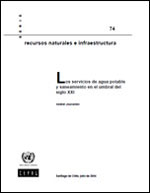 Drinking water supply and sanitation services on the threshold of the XXI century
[347 MB]
Drinking water supply and sanitation services on the threshold of the XXI century
[347 MB]
United Nations Economic Commission for Latin America and the Caribbean (UNECLAC). 2004
The objective of this paper is to analyse the status of drinking water supply and sanitation services in the countries of Latin America and the Caribbean. The study is divided into two parts. The first section consists of an analysis of access to services and their quality. The second section of the study contains an analysis of the reforms carried out in recent years by the countries of the region.

"Each year, more than 800,000 children under five die needlessly from diarrhoea – more than one child a minute. Countless others fall seriously ill, with many suffering long-term health and developmental consequences. Poor sanitation and hygiene are the primary cause. Worldwide, some 2.5 billion people lack the benefits of adequate sanitation. More than 1 billion people practice open defecation. We must break the taboos and make sanitation for all a global development priority"
Ban Ki-moon, UN Secretary Generalon his message for World Toilet Day 2013
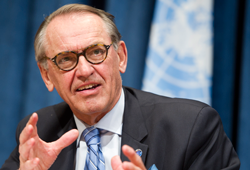
""Despite progress toward the Millennium Development Goals, one in three people do not have a basic toilet. Almost 2,000 children die every day from preventable diarrhoeal diseases. Poor sanitation and water supply result in economic losses estimated at $260 billion annually in developing countries".
Jan Eliasson, UN Deputy Secretary General, on adoption 24 July 2013 of UN General Assembly Resolution ‘Water for All’.
"
Jan Eliasson, UN Deputy Secretary General, on adoption 24 July 2013 of UN General Assembly Resolution ‘Water for All’.
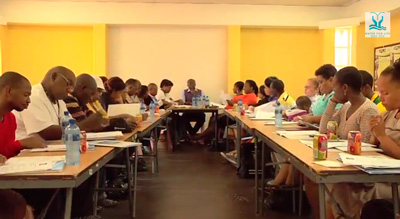 >> Water: our life, our future
>> Water: our life, our future
UNW-DPAC, October 2013
Place: South Africa
Duration: 22mins50sec
The Municipality of eThekwini, Durban, South Africa, won the category 2 ‘Best participatory, communication, awareness-raising and education practice’ 1st edition of ‘Water for Life’ UN-Water Best Practices Award with the initiative ‘A Participatory and Learning Based Approach to Raising Awareness on Water and Sanitation’. This video presents the different components of the initiative and explains what worked and what didn’t when trying to improve access to clean water and sanitation in the municipality.
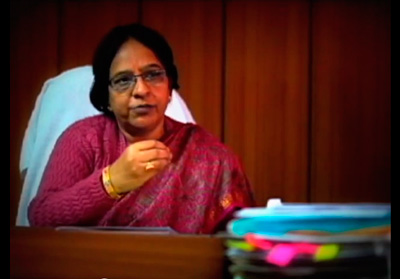 >> India: No Toilet, No Bride
>> India: No Toilet, No Bride
World Bank, 2013
Place: India
Duration: 4min3sec
Nearly half of India's 1.2 billion people don't have access to toilets, especially in rural villages. The lack of sanitation is the cause of one in every ten deaths here. This video describes an initiative by the Indian government supported by the World Bank geared at changing people's behavior when it comes to using toilets.
>> Lake Victoria. Water for Life, the urban challenge
UNTV and UNW-DPAC
Place: Lake Victoria
Duration: 7min31sec
Worldwide, a staggering 90% of wastewater in developing countries is discharged untreated, polluting de world's rivers, lakes and seas. The impacts of bad sanitation on human and ecosystem health in the Lake Victoria region are shown in this video together with concerted actions implemented in Kampala, Uganda, to reverse these conditions.
>> More videos accessible from UN water video library
>> UN fast facts on sanitation 
>> UN-Water Sanitation Fact sheet 
>> Fact Sheet #1: Sanitation for all. Making the right a reality 
>>Fact Sheet #2 – Sanitation is a Good Economic Investment 
>>Fact Sheet #3 – Sanitation Brings Dignity, Equality and Safety 
>>Fact Sheet #4 – Sanitation is Vital for Good Health 
>>Fact Sheet #5 – Sanitation Sustains Clean Environments
>> Photo essay: Progress for Children: Water and Sanitation
UNICEF
>> Photo essay: West and Central Africa's sanitation crisis- Part I of II
UNICEF
>> Photo essay: West and Central Africa's sanitation crisis- Part II of II
UNICEF
Copyright | Terms of use | Privacy notice | Site Index | Fraud alert | Help





